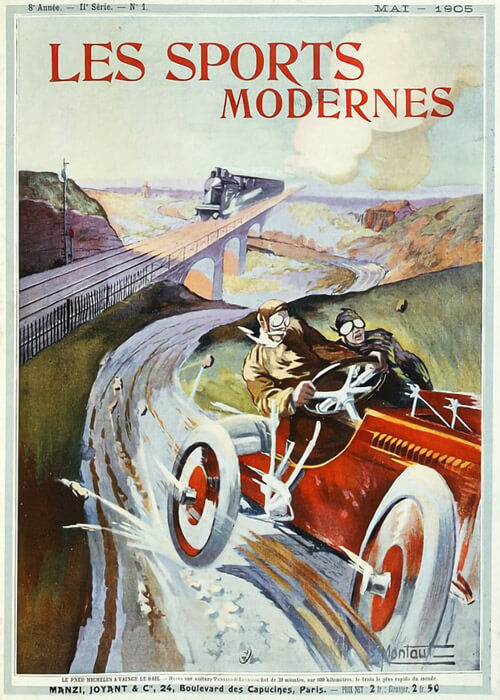City-to-City Races
In the last two decades of the 19th century, inventions were made, and patents were filed for internal combustion engines. Relatively small engines were mounted on or under the up to then known horse driven chariots. And by the mid of the 1890’s, the City-to-City races were initiated, vehicle events over open public roads.
In 1894 the first event was organised by the daily Parisien newspaper “Le Petit Journal”. Pierre Giffard, the chief editor made clear that this event: “Le Concours des Véhicules sans Chevaux” was not meant for speed, but above all: safety, practicality and reliability were the aim. Hence, it was not the first race! The total trajected length was a mere 120 km from Paris to Rouen, and steam- as well as petrol fuelled engines could participate. In total, some 102 vehicles were registered, of which finally 21 were admitted to the event after elimination trials. Then, on a sunny Sunday 22 July 1894, in all some 21 vehicles one after the other got on their way. Eight vehicles driven by steam- and 13 driven by a petrol fuelled engines. Of the latter, almost all were equipped with a German Daimler engine. In my view, one of the first and successful European bilateral cooperations in automotive industry.The first application of a steering wheel equipped vehicle may be noted, although this vehicle, driven by Vacheron, was not very successful.An average vehicle speed of less than about 20 km/h could easily be followed by cyclists. Imagine those new and mostly unknown vehicles passing through the Parsian streets with a lot of noise (some even called them “les touf-toufs”), accompanied by many cyclists.
The fastest of the participants, at an average speed of and a max of 25 km/h was the steam tractor. But the jury judged it not practical, as an extra person for heating was required. The ex-aequo first prize was granted to Peugeot Freres and Panhard-Levassor. This to the steam tractor, which, however, was found to be rather unpractical, as it required an extra person to heat the water. Final classification of le Petit Journal committee made both the Panhard and Peugeot Frères petrol engine cars ex-aequo of first price. Then came the steam wagons and the steering wheel equipped car of Vacheron. The evaluation committee showed that it really understood the hardly readable writings on the wall for petrol engines and steering wheels. All technical innovations and History later on merely conformed their views!
1895 saw the real first race in history organized by, again, Paul Griffard of Le Petit Journal. Now covering a distance of some 1200 miles (!), taking in all but three days travel from Paris to Bordeaux and back! Finally, the gasoline/petrol engine driven car came out as the absolute winners, which was the beginning of the end for steam cars.
Another technical fact was the first application of the pneumatic tyres of Michelin. Although with less success, it was a first application, of which more were to come.
48:48 is the figure that for always would be linked to that first European race, as Emille Levassor on a Panhard won that first ever race in 48 hours and 48 minutes; an average speed of about 26 km/h. He drove alone, almost all day and night through, with a minimum rest. Being the fastest and hance the first on the finish line, didn’t mean that he particularly won the race. As two participants per vehicle were minimal required, Levassor was found not eligible for the win. But history survived that feat and Levassor still stands today as the winner of the first European car race.
In that same year, over the great pond, in the USA on Thanksgiving Day, 28th November 1895, the Chicago-Herald Trial was held. A $2,000 prize was offered for an automobile race from Chicago’s Jackson Park to Evanston, Illinois and back. James Franklin Duryea, driving a Duryea won as one of the six cars in this 54 mile race. It was held during one of Chicago’s great snowstorms, hence the race was very harrowing. Duryea completed the race in 10 hours and 23 minutes, at an average speed of about 8 to 9 km/h. Later that year, the UK followed suit with a similar competion.
In the course of the time, motorcars evolved more and more, and with her, the City-to-City races. Until the 1903 Paris-Madrid race.
In this race, later called the “Race of Death”, resolved in many injured and deaths among onlookers, drivers and mechanics. Now this put a direct end to racing on open roads. But in the meantime, other race series such as the Gordon Bennett Cup, the Vanderbilt Cup and many more were to follow that would later fill the books on the history of motor racing. Interesting read can be found on the brass-car-era site: brasscarera.com
City-to-City Races 1894-1900
City-to-City Races 1901-1903
1894
Paris – Rouen

1895
Paris - Bordeaux

1895
Chicago Herald Trial

1896 - 1902

1903
Paris – Madrid








